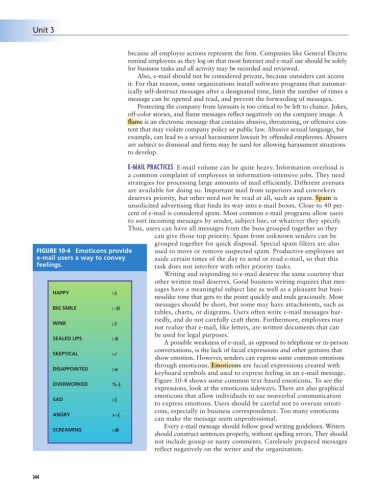Page 257 - Business Principles and Management
P. 257
Unit 3
because all employee actions represent the firm. Companies like General Electric
remind employees as they log on that most Internet and e-mail use should be solely
for business tasks and all activity may be recorded and reviewed.
Also, e-mail should not be considered private, because outsiders can access
it. For that reason, some organizations install software programs that automat-
ically self-destruct messages after a designated time, limit the number of times a
message can be opened and read, and prevent the forwarding of messages.
Protecting the company from lawsuits is too critical to be left to chance. Jokes,
off-color stories, and flame messages reflect negatively on the company image. A
flame is an electronic message that contains abusive, threatening, or offensive con-
tent that may violate company policy or public law. Abusive sexual language, for
example, can lead to a sexual harassment lawsuit by offended employees. Abusers
are subject to dismissal and firms may be sued for allowing harassment situations
to develop.
E-MAIL PRACTICES E-mail volume can be quite heavy. Information overload is
a common complaint of employees in information-intensive jobs. They need
strategies for processing large amounts of mail efficiently. Different avenues
are available for doing so. Important mail from superiors and coworkers
deserves priority, but other need not be read at all, such as spam. Spam is
unsolicited advertising that finds its way into e-mail boxes. Close to 40 per-
cent of e-mail is considered spam. Most common e-mail programs allow users
to sort incoming messages by sender, subject line, or whatever they specify.
Thus, users can have all messages from the boss grouped together so they
can give those top priority. Spam from unknown senders can be
grouped together for quick disposal. Special spam filters are also
FIGURE 10-4 Emoticons provide used to move or remove suspected spam. Productive employees set
e-mail users a way to convey aside certain times of the day to send or read e-mail, so that this
feelings. task does not interfere with other priority tasks.
Writing and responding to e-mail deserve the same courtesy that
other written mail deserves. Good business writing requires that mes-
sages have a meaningful subject line as well as a pleasant but busi-
HAPPY :-)
nesslike tone that gets to the point quickly and ends graciously. Most
messages should be short, but some may have attachments, such as
BIG SMILE : -D
tables, charts, or diagrams. Users often write e-mail messages hur-
riedly, and do not carefully craft them. Furthermore, employees may
WINK ;-)
not realize that e-mail, like letters, are written documents that can
be used for legal purposes.
SEALED LIPS :-X
A possible weakness of e-mail, as opposed to telephone or in-person
conversations, is the lack of facial expressions and other gestures that
SKEPTICAL :-/
show emotion. However, senders can express some common emotions
through emoticons. Emoticons are facial expressions created with
DISAPPOINTED :-e
keyboard symbols and used to express feeling in an e-mail message.
Figure 10-4 shows some common text-based emoticons. To see the
OVERWORKED %-)
expressions, look at the emoticons sideways. There are also graphical
emoticons that allow individuals to use nonverbal communication
SAD :-(
to express emotions. Users should be careful not to overuse emoti-
cons, especially in business correspondence. Too many emoticons
ANGRY >:-(
can make the message seem unprofessional.
Every e-mail message should follow good writing guidelines. Writers
SCREAMING :-@
should construct sentences properly, without spelling errors. They should
not include gossip or nasty comments. Carelessly prepared messages
reflect negatively on the writer and the organization.
244

